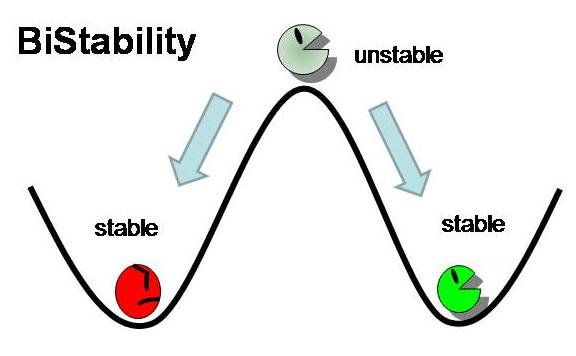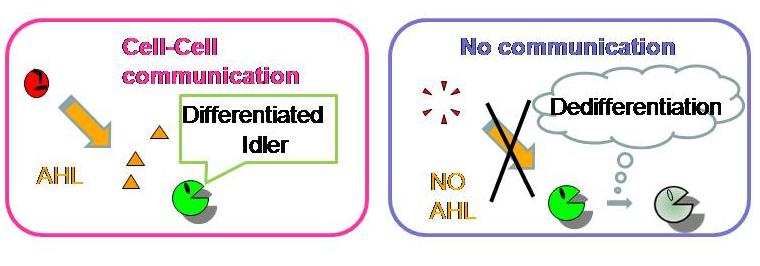Tokyo/Requirements
From 2007.igem.org
(→1. Bistability) |
(→2. Cell-cell communication) |
||
| (30 intermediate revisions not shown) | |||
| Line 1: | Line 1: | ||
<!--メニュー--> | <!--メニュー--> | ||
__NOTOC__ | __NOTOC__ | ||
| - | ==[[Tokyo_Tech|Abstract]] [[Tokyo/Model|Concept & Model]] [[Tokyo/Requirements |Requirements]] [[Tokyo/Genetic circuit|Genetic_circuit]] [[Tokyo/Works|Works]] [[Tokyo/ | + | ==[[Tokyo_Tech|Abstract]] [[Tokyo/Model|Concept & Model]] [[Tokyo/Requirements |Requirements]] [[Tokyo/Genetic circuit|Genetic_circuit]] [[Tokyo/Works|Works]] [[Tokyo/About our team|About_our_team]]== |
<!--我々のモデルの最も重要な点を挙げると、それは共存安定である。 | <!--我々のモデルの最も重要な点を挙げると、それは共存安定である。 | ||
共存安定とは、複数のタイプのものが、一定の割合で存在し続け、環境の変化に対応できることである。 | 共存安定とは、複数のタイプのものが、一定の割合で存在し続け、環境の変化に対応できることである。 | ||
我々は共存安定を動的平衡(化学平衡のような安定)でなく実装する必要がある。--> | 我々は共存安定を動的平衡(化学平衡のような安定)でなく実装する必要がある。--> | ||
| + | <!--==”共存安定”をなすために必要なこと==--> | ||
| - | The most important and underlying point of our model is that the system is stable against environmental changes when two | + | == What is necessary for "Balanced differentiation"? == |
| - | + | The most important and underlying point of our model is that the system is stable against environmental changes when two types of differentiated individuals coexist, called "Balanced differentiation." Our project has aimed at this "Balanced differentiation" but not dynamic equilibrium such as chemical ones. | |
<!--共存安定をなりたたせるために必要な要素は以下の3つである | <!--共存安定をなりたたせるために必要な要素は以下の3つである | ||
1.双安定 | 1.双安定 | ||
2.Cell-Cellコミュニケーション | 2.Cell-Cellコミュニケーション | ||
3.2つの機能が1つの細胞から実現されること--> | 3.2つの機能が1つの細胞から実現されること--> | ||
| - | <br>To achieve this | + | <br>To achieve this “Balanced differentiation", our model requires |
| - | <br>1. bistability | + | <br>1. differentiation(=bistability) generated by mutual-inhibition circuit. |
| - | <br>2. cell-cell communication by | + | <br>2. cell-cell communication by quorum sensing |
| - | [[Image: | + | [[Image:Stable.jpg|thumb|250px| '''Fig.1: Differentiation(=bistability)''' <br>Cells with the same gene take either of two differentiated states, A (worker, red) or B (idler, green) stably.]] |
<!--それぞれについて以下で説明する。--> | <!--それぞれについて以下で説明する。--> | ||
| - | ====1. | + | ====1. Differentiation(=bistability)==== |
<!--これがないと、動的平衡になってしまう。<br>Without this, our model is subject to dynamic equilibrium.--> | <!--これがないと、動的平衡になってしまう。<br>Without this, our model is subject to dynamic equilibrium.--> | ||
| - | ''' | + | '''~ at an individual level ~''' |
| - | For " | + | For "balanced differentiation" in our model, two types of cells should coexist stably. Therefore, cells with '''THE SAME GENE SET''' need to take either of '''TWO DIFFERENTIATED STATES''', A (Worker) or B (Idler) in our project as shown in Fig. 1. '''In order to distinguish from dynamic stability, "balanced differentiation" must be achieved by two distinct states inconvertible each other.''' This bistability can be achieved by mutual-inhibition circuit. |
<!--[[Image:collective.jpg|thumb|350px| '''Fig.2: Coexistence]]--> | <!--[[Image:collective.jpg|thumb|350px| '''Fig.2: Coexistence]]--> | ||
<!--<br>'''1-2. At a collective level''' | <!--<br>'''1-2. At a collective level''' | ||
<br> | <br> | ||
| - | To achieve " | + | To achieve "balanced differentiation", each cell needs to recognize cell types - the ratio of A and B - around itself. |
As is often the case in natural bacteria, our modified cells here sense the types of coexisting cells by cell-cell communication called quorum sensing. Under the coexistence of A and B at a specific ratio, the whole system (or group) is collectively stable. Fig. 2 simply shows this scheme. --> | As is often the case in natural bacteria, our modified cells here sense the types of coexisting cells by cell-cell communication called quorum sensing. Under the coexistence of A and B at a specific ratio, the whole system (or group) is collectively stable. Fig. 2 simply shows this scheme. --> | ||
<!--このsectionでquorum sensingの話が出てくるのはおかしいのでは?そもそもbistabilityはindividual cellの性質として重要なのであって、bistabilityのcollective levelの説明は必要ないと思います。なのでこの1.2はなくてよいと思います。--> | <!--このsectionでquorum sensingの話が出てくるのはおかしいのでは?そもそもbistabilityはindividual cellの性質として重要なのであって、bistabilityのcollective levelの説明は必要ないと思います。なのでこの1.2はなくてよいと思います。--> | ||
<br> | <br> | ||
| - | + | <br> | |
| - | + | ||
====2. Cell-cell communication ==== | ====2. Cell-cell communication ==== | ||
| - | When this | + | When this balanced differentiation is disrupted, by removing all the A types for example, the rest individual B cells sense the change. Their differentiated states become unstable as if they become upset. Then all cells dedifferentiate, but after a while, redifferentiation is triggered by cell-cell communication. As a result, at a certain ratio of A and B again, the whole system comes back to a stable state. |
| + | [[Image:Cellcell.JPG|thumb|450px| '''Fig.2: Cell-cell communication'''<br>Intercellular interaction is established by communication molecule AHL. When enough AHL is produced by the workers, the idlers are stable; however, if it is not ~ communication being interrupted, ~ they dedifferentiate. Thus, cells can sense the surrounding cell types. ]] | ||
Latest revision as of 05:06, 27 October 2007
Abstract Concept & Model Requirements Genetic_circuit Works About_our_team
What is necessary for "Balanced differentiation"?
The most important and underlying point of our model is that the system is stable against environmental changes when two types of differentiated individuals coexist, called "Balanced differentiation." Our project has aimed at this "Balanced differentiation" but not dynamic equilibrium such as chemical ones.
To achieve this “Balanced differentiation", our model requires
1. differentiation(=bistability) generated by mutual-inhibition circuit.
2. cell-cell communication by quorum sensing
1. Differentiation(=bistability)
~ at an individual level ~
For "balanced differentiation" in our model, two types of cells should coexist stably. Therefore, cells with THE SAME GENE SET need to take either of TWO DIFFERENTIATED STATES, A (Worker) or B (Idler) in our project as shown in Fig. 1. In order to distinguish from dynamic stability, "balanced differentiation" must be achieved by two distinct states inconvertible each other. This bistability can be achieved by mutual-inhibition circuit.
2. Cell-cell communication
When this balanced differentiation is disrupted, by removing all the A types for example, the rest individual B cells sense the change. Their differentiated states become unstable as if they become upset. Then all cells dedifferentiate, but after a while, redifferentiation is triggered by cell-cell communication. As a result, at a certain ratio of A and B again, the whole system comes back to a stable state.

